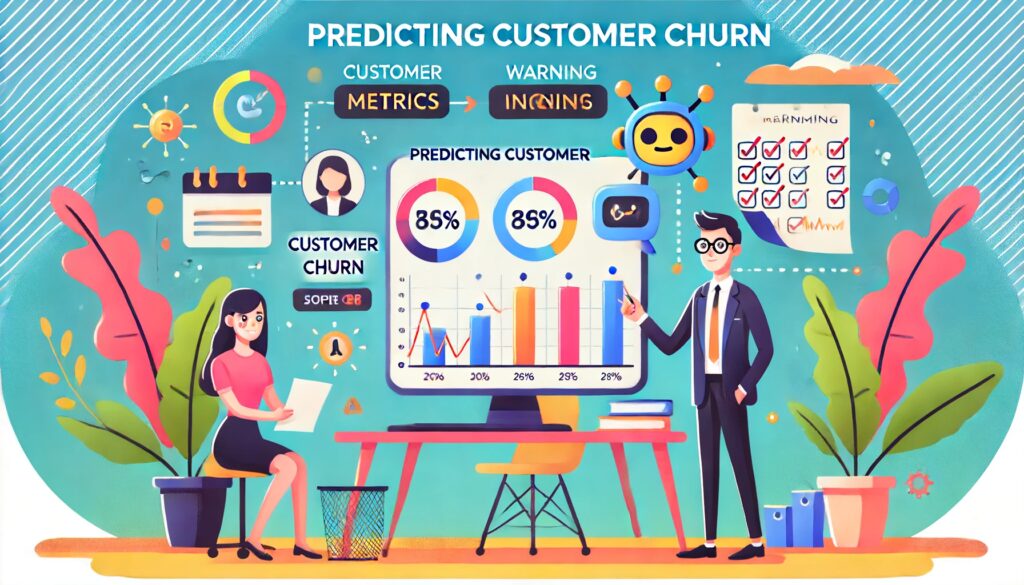
Master AI-Powered Churn Prediction
In today’s competitive market, customer retention means incremental growth. Predicting customer churn allows businesses to get ahead in solving problems to ensure the customer remains happy. With the help of AI models, organizations try to recognize at-risk customers and apply targeted strategies to keep customers interested.
This guide would walk you through building AI models to predict customer churn and indicate associated best practices, challenges, and actionable insights for best results.
Why Predicting Customer Churn Matters
Predictive churn modeling helps businesses focus on customers most likely to leave. As Amy Gallo from the Harvard Business Review notes, acquiring a new customer is significantly more expensive than retaining an existing one. Emphasizing retention can increase revenue by up to 80% over 18-24 months, according to a study by Toptal. This underscores the importance of churn prediction in maintaining a healthy customer base and ensuring long-term success.
Define the Problem
Customer churn prediction aims to identify customers who are likely to leave a service or stop purchasing products. This helps in taking proactive measures to retain them.

Data Collection
Key Data Points
- Product usage data: Track how and when customers use your product. This includes feature usage, customer behavior, and interaction data (UserMotion).
- Customer success metrics: Net Promoter Score (NPS) and Customer Satisfaction (CSAT) surveys provide insights into customer loyalty and satisfaction (UserMotion).
- Payment data: Analyze transaction history, payment methods, and subscription changes to understand customer commitment and potential financial issues (UserMotion).
These data points offer a holistic view of customer interactions and behaviors, essential for accurate churn prediction.
Data Preparation
Cleaning and Preparing Data
- Cleaning data: Handle missing values and outliers to ensure data quality.
- Encoding categorical variables: Convert categories into numerical values for machine learning algorithms.
- Normalizing numerical features: Standardize data to improve model performance.
Proper data preparation enhances the accuracy and reliability of the predictive model.
Exploratory Data Analysis (EDA)
Analyzing Data Patterns
EDA helps uncover patterns and relationships in your data. Use visualizations like line plots, bar charts, and heatmaps to analyze churn rates over time and across different segments. Correlation matrices and scatter plots can identify relationships between features, guiding feature selection and model refinement (LeewayHertz – AI Development Company).
Feature Selection
Identifying Relevant Features
Selecting the most relevant features is crucial for model accuracy. Techniques like random forests and gradient boosting machines provide feature importance scores, helping prioritize impactful variables. This process reduces model complexity and enhances interpretability.
Create new features that can help the model understand customer behavior better:
- Recency, Frequency, Monetary (RFM) Metrics: Calculate recency, frequency, and monetary value of purchases.
- Customer Lifetime Value (CLV): Estimate the total value a customer brings over their lifetime.
- Engagement Metrics: Measure engagement through interactions, usage patterns, and feedback.
Model Selection and Training
Choosing the Right Algorithm
Choosing the right machine learning algorithm depends on your dataset and business needs. Common algorithms include logistic regression, decision trees, random forests, support vector machines, and neural networks. Train your models on historical data, splitting it into training and testing sets to evaluate performance.
Choose appropriate machine learning models for churn prediction. Common choices include:
- Logistic Regression
- Decision Trees
- Random Forests
- Gradient Boosting Machines (GBM)
- Support Vector Machines (SVM)
- Neural Networks
Split the data into training and test sets. Train multiple models and tune hyperparameters using techniques like cross-validation.
import pandas as pd
from sklearn.model_selection import train_test_split
from sklearn.preprocessing import StandardScaler
from sklearn.ensemble import RandomForestClassifier
from sklearn.metrics import accuracy_score, confusion_matrix, classification_report
import joblib
# Load your dataset
data = pd.read_csv('customer_data.csv')
# Preprocessing
data.fillna(method='ffill', inplace=True)
data = pd.get_dummies(data, drop_first=True)
# Feature and target variables
X = data.drop('churn', axis=1)
y = data['churn']
# Train-test split
X_train, X_test, y_train, y_test = train_test_split(X, y, test_size=0.3, random_state=42)
# Standardize the features
scaler = StandardScaler()
X_train = scaler.fit_transform(X_train)
X_test = scaler.transform(X_test)
# Model selection and training
model = RandomForestClassifier(n_estimators=100, random_state=42)
model.fit(X_train, y_train)
# Save the model and scaler
joblib.dump(model, 'churn_model.pkl')
joblib.dump(scaler, 'scaler.pkl')
# Predictions
y_pred = model.predict(X_test)
# Evaluation
print('Accuracy:', accuracy_score(y_test, y_pred))
print('Confusion Matrix:\n', confusion_matrix(y_test, y_pred))
print('Classification Report:\n', classification_report(y_test, y_pred))Evaluating Models
Evaluate models using metrics like accuracy, precision, recall, F1 score, and the area under the ROC curve. Cross-validation techniques help ensure robust performance and avoid overfitting. Ensemble methods like bagging and boosting can further improve accuracy by combining predictions from multiple models.
from sklearn.metrics import roc_auc_score, roc_curve
import matplotlib.pyplot as plt
# Calculate ROC AUC
roc_auc = roc_auc_score(y_test, y_pred)
fpr, tpr, thresholds = roc_curve(y_test, model.predict_proba(X_test)[:,1])
# Plot ROC curve
plt.figure()
plt.plot(fpr, tpr, color='darkorange', lw=2, label='ROC curve (area = %0.2f)' % roc_auc)
plt.plot([0, 1], [0, 1], color='navy', lw=2, linestyle='--')
plt.xlim([0.0, 1.0])
plt.ylim([0.0, 1.05])
plt.xlabel('False Positive Rate')
plt.ylabel('True Positive Rate')
plt.title('Receiver Operating Characteristic')
plt.legend(loc="lower right")
plt.show()Deployment and Monitoring
Implementing and Tracking Models
Deploy the best-performing model into a production environment and continuously monitor its performance. Adapt to changing customer behaviors and recalibrate the model as needed to maintain accuracy.
from flask import Flask, request, jsonify
import joblib
# Load the model and scaler
model = joblib.load('churn_model.pkl')
scaler = joblib.load('scaler.pkl')
# Initialize Flask app
app = Flask(__name__)
@app.route('/predict', methods=['POST'])
def predict():
data = request.get_json()
df = pd.DataFrame(data)
df = pd.get_dummies(df, drop_first=True)
df = df.reindex(columns=model.feature_names_in_, fill_value=0)
scaled_data = scaler.transform(df)
prediction = model.predict(scaled_data)
return jsonify({'prediction': prediction.tolist()})
if __name__ == '__main__':
app.run(debug=True)Monitor and Maintain the Model
After deploying the churn prediction model, continuous monitoring and maintenance are crucial to ensure its ongoing accuracy and effectiveness. Here’s how you can do it:
Set Up Monitoring Tools
Use tools and platforms that allow you to monitor the performance of your deployed models. Examples include:
- AWS SageMaker Model Monitor
- Azure Machine Learning Monitoring
- Google AI Platform Continuous Evaluation
- Open-source tools like Prometheus and Grafana
Track Key Metrics
Regularly track and log key performance metrics such as accuracy, precision, recall, F1-score, and AUC-ROC. Monitor these metrics over time to identify any degradation in model performance.
Drift Detection
Implement data and concept drift detection mechanisms to identify changes in the data distribution or changes in the relationship between input features and the target variable. Libraries like alibi-detect and scikit-multiflow can help detect drift.
Retraining Strategy
Develop a strategy for periodic retraining of your model. This could be based on:
- Scheduled retraining: Retrain the model at regular intervals (e.g., monthly, quarterly).
- Performance triggers: Retrain the model when performance metrics fall below a certain threshold.
- Data triggers: Retrain the model when new, significant batches of data are available.
Automate the Retraining Process
Automate the retraining pipeline using tools like Apache Airflow, Kubeflow, or cloud-specific pipelines like AWS Step Functions, Azure Pipelines, or Google Cloud Composer. This ensures that your model stays up-to-date with minimal manual intervention.
Interpret and Act on Predictions
Interpreting the predictions made by your churn model is crucial for taking effective actions. Here are some steps and tools to help with interpretation and action:
Model Interpretation Tools
Use tools to interpret the output of your model and understand the factors influencing the predictions:
- SHAP (SHapley Additive exPlanations): Provides a unified approach to explain the output of machine learning models.
- LIME (Local Interpretable Model-agnostic Explanations): Explains individual predictions by approximating the model locally with an interpretable model.
- Feature importance: Use feature importance scores provided by tree-based models (like Random Forests) to understand the most significant factors.
Analyze Prediction Results
Segment the customers based on their churn probability and identify common characteristics among high-risk customers:
- High-risk customers: Customers with a high probability of churning. Focus retention efforts on this group.
- Medium-risk customers: Customers with a moderate risk of churning. Engage with this group to reduce their risk.
- Low-risk customers: Customers with a low probability of churning. Ensure they remain satisfied to maintain their loyalty.
Develop Retention Strategies
Based on the insights gained from your model, develop targeted retention strategies:
- Personalized offers: Provide personalized discounts, offers, or rewards to high-risk customers.
- Enhanced support: Improve customer service and support for high-risk customers.
- Customer feedback: Collect feedback from high-risk customers to understand their concerns and address them promptly.
- Loyalty programs: Implement loyalty programs to reward long-term customers and encourage their continued patronage.
Implement and Measure Impact
Deploy the retention strategies and measure their impact on reducing churn. Use A/B testing or other experimental designs to evaluate the effectiveness of different interventions. Continuously iterate on the strategies based on the results.
Example of a Churn Prediction Workflow
Data Collection and Preprocessing
import pandas as pd
from sklearn.model_selection import train_test_split
from sklearn.preprocessing import StandardScaler
from sklearn.ensemble import RandomForestClassifier
import joblib
# Load dataset
data = pd.read_csv('customer_data.csv')
data.fillna(method='ffill', inplace=True)
data = pd.get_dummies(data, drop_first=True)
# Features and target variable
X = data.drop('churn', axis=1)
y = data['churn']
# Train-test split
X_train, X_test, y_train, y_test = train_test_split(X, y, test_size=0.3, random_state=42)
# Feature scaling
scaler = StandardScaler()
X_train = scaler.fit_transform(X_train)
X_test = scaler.transform(X_test)
# Model training
model = RandomForestClassifier(n_estimators=100, random_state=42)
model.fit(X_train, y_train)
# Save the model and scaler
joblib.dump(model, 'churn_model.pkl')
joblib.dump(scaler, 'scaler.pkl')Model Evaluation
from sklearn.metrics import accuracy_score, confusion_matrix, classification_report, roc_auc_score, roc_curve
import matplotlib.pyplot as plt
# Predictions
y_pred = model.predict(X_test)
# Evaluation metrics
print('Accuracy:', accuracy_score(y_test, y_pred))
print('Confusion Matrix:\n', confusion_matrix(y_test, y_pred))
print('Classification Report:\n', classification_report(y_test, y_pred))
# ROC curve
roc_auc = roc_auc_score(y_test, y_pred)
fpr, tpr, thresholds = roc_curve(y_test, model.predict_proba(X_test)[:,1])
plt.figure()
plt.plot(fpr, tpr, color='darkorange', lw=2, label='ROC curve (area = %0.2f)' % roc_auc)
plt.plot([0, 1], [0, 1], color='navy', lw=2, linestyle='--')
plt.xlim([0.0, 1.0])
plt.ylim([0.0, 1.05])
plt.xlabel('False Positive Rate')
plt.ylabel('True Positive Rate')
plt.title('Receiver Operating Characteristic')
plt.legend(loc="lower right")
plt.show()Model Deployment
from flask import Flask, request, jsonify
import joblib
# Load the model and scaler
model = joblib.load('churn_model.pkl')
scaler = joblib.load('scaler.pkl')
# Initialize Flask app
app = Flask(__name__)
@app.route('/predict', methods=['POST'])
def predict():
data = request.get_json()
df = pd.DataFrame(data)
df = pd.get_dummies(df, drop_first=True)
df = df.reindex(columns=model.feature_names_in_, fill_value=0)
scaled_data = scaler.transform(df)
prediction = model.predict(scaled_data)
return jsonify({'prediction': prediction.tolist()})
if __name__ == '__main__':
app.run(debug=True)By following these extended steps, you can develop, deploy, monitor, and maintain an effective customer churn prediction model. This approach helps businesses proactively address churn and implement targeted retention strategies based on data-driven insights.
Identifying High-Risk Customers
Proactive Retention Strategies
The deployed model can predict churn probabilities, allowing you to identify high-risk customers. Use these predictions to implement targeted retention strategies, such as personalized offers or enhanced support.
Visualizing Churn Patterns
Using Visual Tools
Visualizations help understand churn trends across different customer segments. Heatmaps and clustering algorithms reveal which groups are more likely to churn, providing insights for targeted interventions.
Segmenting Customers
Tailored Retention Strategies
Customer segmentation involves grouping customers based on similar characteristics or behaviors. Clustering algorithms like K-Means can uncover segments with higher churn rates, enabling tailored retention strategies for each group.
Using Predictive Insights
Informing Business Strategies
Insights from churn prediction models can inform broader business strategies. For example, identifying common reasons for churn (e.g., poor customer service, high prices) can guide improvements in products and services, enhancing overall customer satisfaction .
Integrating with CRM Systems
Automation and Monitoring
Integrate churn prediction models with CRM systems for automated monitoring and proactive engagement. Tools like health scoring and automation playbooks streamline the process of identifying and addressing at-risk customers.
Leveraging AI for Enhanced Predictions
Advanced AI Techniques
Advanced AI models, including those using natural language processing (NLP) and deep learning, can enhance churn prediction accuracy. These models analyze complex patterns in customer interactions and feedback, providing deeper insights into churn drivers.
Challenges and Limitations
Overcoming Obstacles
Building effective churn prediction models involves overcoming challenges like data quality issues, lack of domain knowledge, and dealing with concept drift. Continuous learning and adaptation are necessary to maintain model relevance and accuracy.
Future Trends in Churn Prediction
Innovations and Trends
The future of churn prediction lies in integrating real-time analytics, leveraging big data, and utilizing advanced AI techniques. Continuous innovation in these areas will further enhance the ability of businesses to predict and mitigate customer churn effectively.


Conclusion
Predicting customer churn with AI models enables businesses to proactively address retention challenges, ensuring long-term success. By following best practices in data collection, preparation, analysis, and model deployment, companies can build robust churn prediction models that drive strategic decision-making and enhance customer satisfaction.





